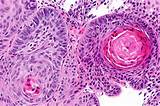Esophageal cancer pathophysiology: Difference between revisions
| Line 16: | Line 16: | ||
Atypical squamous cells with invasion through the basement membrane: | Atypical squamous cells with invasion through the basement membrane: | ||
*Cytology: | *Cytology: | ||
**Nucleus - | **Nucleus - typically central | ||
** | **Mitotic activity | ||
**Cytoplasm - "dense-appearing", typically eosinophilic (may be intensely eosinophilic) | **Cytoplasm - "dense-appearing", typically eosinophilic (may be intensely eosinophilic) | ||
*Squamous whorls may be present<ref>{{Cite web | title =Squamous cell carcinoma of the esophagus | **Squamous whorls may be present<ref>{{Cite web | title =Squamous cell carcinoma of the esophagus | ||
| url =http://librepathology.org/wiki/index.php/Squamous_cell_carcinoma_of_the_esophagus }}</ref> | | url =http://librepathology.org/wiki/index.php/Squamous_cell_carcinoma_of_the_esophagus }}</ref> | ||
Revision as of 14:41, 6 December 2017
|
Esophageal cancer Microchapters |
|
Diagnosis |
|---|
|
Treatment |
|
Case Studies |
|
Esophageal cancer pathophysiology On the Web |
|
American Roentgen Ray Society Images of Esophageal cancer pathophysiology |
|
Risk calculators and risk factors for Esophageal cancer pathophysiology |
Editor-In-Chief: C. Michael Gibson, M.S., M.D. [1]Associate Editor(s)-in-Chief: Hadeel Maksoud M.D.[2]
Overview
The pathophysiology of esophageal cancer depends on the histological subtype.
Pathophysiology
The esophagus is lined by nonkeratinized stratified squamous epithelium. This lining is maintained as long as there are no stressors leading to a metaplastic change. These stressors may include genetic factors, chronic alcoholism, smoking, ingesting spicy foods and hot liquids frequently, and chronic gastroesophageal reflux. Over time a dysplastic change occurs followed by a metaplastic change which may be of the squamous cell or adenocarcinoma type.[1]
Pathology
Microscopic pathology
Squamous cell carcinoma
Atypical squamous cells with invasion through the basement membrane:
- Cytology:
- Nucleus - typically central
- Mitotic activity
- Cytoplasm - "dense-appearing", typically eosinophilic (may be intensely eosinophilic)
- Squamous whorls may be present[2]

Adenocarcinoma[3]
- Invading cell clusters or glands
- Cribriforming (more than rare) or desmoplasia or "deep" invasion (into submucosa)
- Nuclear atypia of malignancy:
- Size variation
- Shape variation
- Staining variation
- Mitoses (common)

References
- ↑ Quante M, Graham TA, Jansen M (2017). "Insights into the Pathophysiology of Esophageal Adenocarcinoma". Gastroenterology. doi:10.1053/j.gastro.2017.09.046. PMID 29037468.
- ↑ "Squamous cell carcinoma of the esophagus".
- ↑ "Esophageal adenocarcinoma".